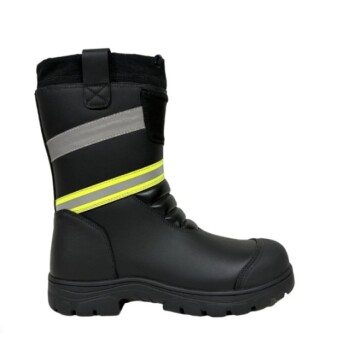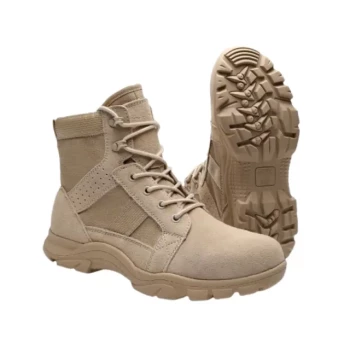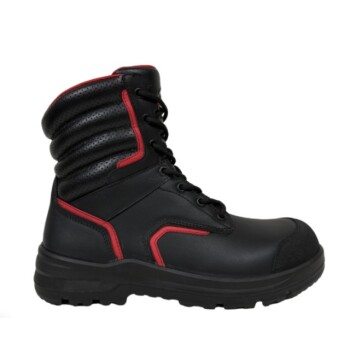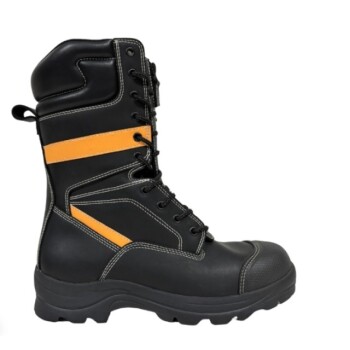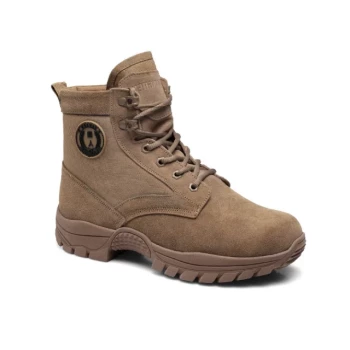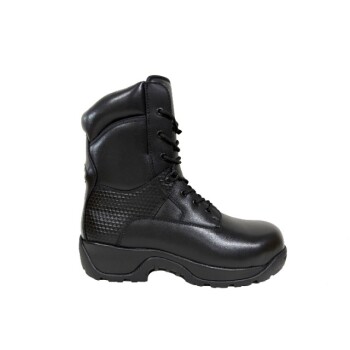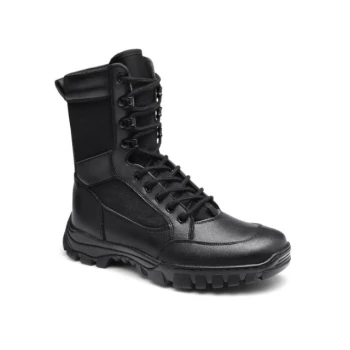The fundamental difference between a hiking boot and a hiking shoe lies in ankle support, weight, and overall rigidity. Hiking boots feature a high cut that extends above the ankle, offering maximum support and protection, whereas hiking shoes have a low cut, similar to a standard sneaker, prioritizing flexibility and lower weight.
The choice is not about which is "better," but which is the right tool for the specific terrain and load you plan to carry. It is a direct trade-off between the stability and protection of a boot versus the lightweight agility of a shoe.
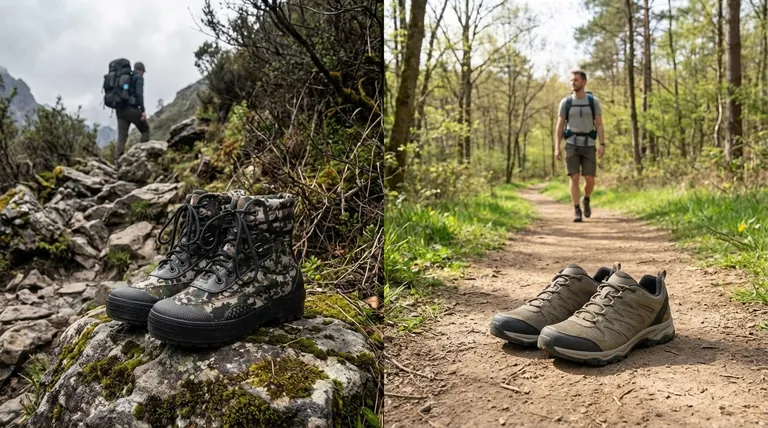
Deconstructing the Core Differences
To make an informed decision, you must understand how the construction of each type of footwear affects its performance on the trail.
Ankle Support and Cut Height
A hiking boot’s defining feature is its high-cut design, which wraps around and supports the ankle. This structure helps prevent twists and sprains on uneven, rocky, or unmaintained trails.
Hiking shoes have a low-cut design that stops below the ankle. This provides significantly more freedom of movement but offers minimal protection against ankle rolls.
Weight and Flexibility
Hiking boots are inherently heavier and stiffer due to their robust materials and supportive construction. This rigidity protects your feet from sharp rocks underfoot but can feel cumbersome and require more energy to lift with each step.
Hiking shoes are significantly lighter and more flexible. Their construction mimics a sturdy running shoe, making them feel more nimble and less fatiguing on long, flat trails.
Underfoot Protection and Midsoles
Boots typically feature thicker, stiffer midsoles. This creates a rigid platform that shields your feet from the impact of rugged terrain, which is critical when carrying a heavy backpack.
Shoes have more pliable midsoles that allow your foot to feel the ground more. While comfortable on well-groomed paths, they offer less protection from sharp objects underfoot.
When to Choose Each Type
Your decision should be dictated by three key factors: the terrain you'll be hiking, the weight of your pack, and the expected weather conditions.
The Case for Hiking Boots
Choose hiking boots when your plans involve technical or unpredictable terrain. Their superior ankle support and underfoot protection are essential for off-trail scrambling, steep inclines, and rocky paths.
They are also the clear choice when carrying a heavy backpack (over 25-30 lbs). The added weight of a pack increases the stress on your ankles and feet, and the support from a boot is necessary to maintain stability and prevent injury. Finally, their durable construction and taller cut offer better protection in cold or wet weather.
The Case for Hiking Shoes
Opt for hiking shoes for well-maintained trails and day hikes. Their lightweight and flexible nature reduces fatigue and allows for a faster pace on predictable surfaces.
They are ideal when carrying a light daypack or no pack at all. Without a heavy load, the need for extreme ankle support diminishes, and the comfort and breathability of a shoe become more advantageous, especially in warm, dry weather.
Understanding the Trade-offs
Neither option is perfect for every situation. Being aware of the inherent compromises is critical for avoiding discomfort and potential injury.
The Boot's Burden: Weight and Break-in
The primary downside of a hiking boot is its weight and stiffness. This can lead to faster fatigue and a "clunky" feeling, especially for those accustomed to lighter footwear. Boots also typically require a dedicated break-in period to soften and conform to your foot, risking blisters if not done properly.
The Shoe's Vulnerability: Less Protection
A hiking shoe's main weakness is its lack of protection. The low cut leaves your ankle exposed to sprains and impacts. It also allows trail debris like pebbles and sand to enter more easily, and the lower profile offers less defense against water from puddles or stream crossings.
Making the Right Choice for Your Hike
Select your footwear based on the demands of your intended journey, not just on general preference.
- If your primary focus is stability on rugged terrain or carrying a heavy pack: A hiking boot is the non-negotiable choice for its essential support and protection.
- If your primary focus is speed and comfort on well-groomed trails with a light pack: A hiking shoe will provide the agility and breathability you need.
- If you are hiking in unpredictable, cold, or wet conditions: The superior coverage and water resistance of a boot are your safest option.
- If you are prone to ankle injuries regardless of the terrain: The added support of a hiking boot provides valuable peace of mind.
Ultimately, the right footwear is the one that best matches the trail ahead, ensuring your safety, comfort, and enjoyment.
Summary Table:
| Feature | Hiking Boot | Hiking Shoe |
|---|---|---|
| Ankle Support | High-cut, maximum support | Low-cut, minimal support |
| Weight & Flexibility | Heavy, rigid | Lightweight, flexible |
| Best For | Rugged terrain, heavy packs | Groomed trails, light packs |
| Ideal Conditions | Cold, wet, unpredictable weather | Warm, dry, predictable weather |
Need the Right Footwear for Your Customers?
As a large-scale manufacturer, 3515 produces a comprehensive range of hiking boots and shoes for distributors, brand owners, and bulk clients. Our production capabilities ensure high-quality, durable footwear tailored to any terrain.
Partner with us to:
- Source reliable hiking footwear for your market.
- Benefit from our extensive manufacturing expertise.
- Get custom solutions for your specific needs.
Contact 3515 today to discuss your production requirements and elevate your product line!
Visual Guide

Related Products
- Wholesale High-Traction Camo Boots - Custom Manufacturer for Brands
- Factory-Direct Wholesale Canvas Boots with High-Traction Rubber Soles
- Safety Footwear Wholesale Manufacturer for Custom OEM/ODM Production
- Factory Direct Wholesale Rain Boots Durable Waterproof & Fully Customizable
- High Performance Fire-Retardant Waterproof Safety Boots
People Also Ask
- What is the name of the new boot model mentioned in the article? Introducing the Boots Original Camo Red Desert
- What historical event marked the first use of camouflage in military apparel? The Napoleonic Wars' Tactical Shift
- Why might wearing multiple pairs of socks be counterproductive? Avoid This Common Cold-Weather Mistake
- How is PVC produced? From Salt & Gas to a Versatile Polymer
- What technologies are used in the men's 8-inch camo lace-up boots? A Guide to Rugged Outdoor Performance




